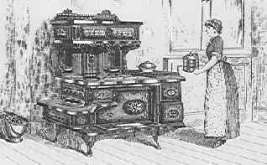 1860 |  1870 |  1880 |  1890 |  1900 |
 1910 |
 1860 |  1870 |  1880 |  1890 |  1900 |
 1910 |
|
1870s New Cooking Gadgets.
Can opener with cutting wheel.
Four-tined silver fork, beginning the end of eating with knife.
Square bottomed paper-bags.
1870s New Foods.
| Saccharin: 1879 | Cubed sugar | Synthetic vanilla |
| Rootbeer | Wheatena | Nestle's Infant Milk Food |
| Milk chocolate | Ice cream soda | Commercial production of margarine |
| Japanese beef-eating taboo ends |
1870s New Food Companies.
| Lipton | Pillsbury & Co. | F. & J. Heinz |
| Quaker Mills | Hills Brothers | Grand Union Tea Co. |
| Confectioner's Journal |
1870s Food Industry Beginnings.
| Milking machines | Glass milk bottles | Orange crates |
| Pressure cooking in food canning: 1874 | Frozen meat shipments: 1877 | Mechanical cream separator |
| Porcelain rollers make roller-milling flour (wheat germ removal) standard practice | William Underwood first to register U.S. food trademark (Red Devil) |
1870s Farming Progress.
| Bison herds disappearing | Large US agricultural exports | European farm land shortage |
| Quantity banana imports to US | Long-distance cattle driving | Barbed wire fences |
| Vast US acreage for farming and cattle ranches |

It is the commendable ambition in the English bakers to impart that peculiar tint so highly prized by connoisseurs, and so successfully produced at Vienna and Paris. At Vienna, it has long been known that if the hearth of an oven be cleaned with a moistened wisp of straw, the crust of bread baked in it immediately after presents a rich yellow tint; the theory is that the aqueous vapor retained on the oven has a beneficial effect. The proper temperature of the oven is between 200 and 225 degrees Centigrade, equivalent to 424 and 480 degrees Fahr., and may be known by the emission of sparks from a piece of wood rubbed on the oven. The dough loses about 1-7th of its weight if baked in batches, but fully 1-6th if baked in small loaves and placed in the oven separately. The best bread contains about 11-16ths of its weight of added water, and common bread often much more than ¼. The proportion of water in the London bread has greatly increased of late years, owing to the use of the fraudulent method of making the dough with rice jelly or moss jelly, in which Iceland moss, Irish moss, or other mosses are used, | Orange Rock Candy is made by flavoring the syrup with a couple of teaspoonfuls of orange flower water, and coloring with saffron, just as the syrup is about to be taken from the fire. |
| More Kitchens. | |||||
 1860 |  1870 |  1880 |  1890 |  1900 |
 1910 |
| Cookbooks | House-Plan Books | Samples | Site Index | Home |